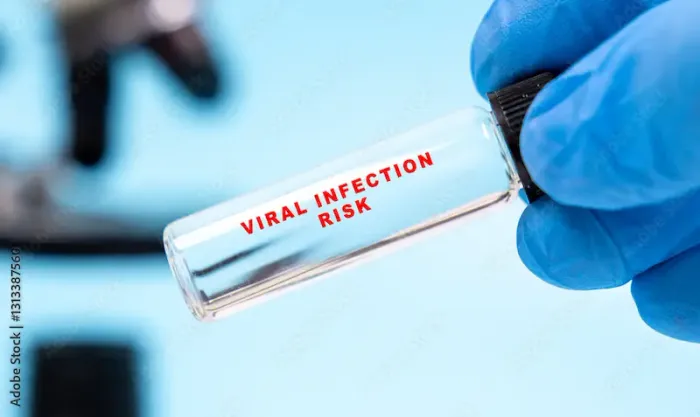Guide to Viral Marker Test Purpose And Normal Range
Guide to Viral Marker Tests: Understand the purpose, what specific infections they detect (like Hepatitis and HIV), and interpret the normal range results. Essential information for health check-ups and diagnosis.

Written by Dr. J T Hema Pratima
Reviewed by Dr. Dhankecha Mayank Dineshbhai MBBS
Last updated on 29th Oct, 2025

Introduction
Viral infections can be confusing because the lab reports often show terms like reactive, non-reactive, positive, negative, IgM, IgG, antigen, and viral load. This guide demystifies the viral marker test, normal range expectations, and how doctors interpret results for infections like hepatitis B and C, HIV, dengue, COVID-19, EBV, and CMV. Whether you are being screened before a medical procedure, monitoring a known infection, or simply curious after seeing “normal range” on a lab form, this article will help you read the numbers (and non-numbers) with confidence. We’ll explain what “normal” means when tests are qualitative versus quantitative, how window periods affect accuracy, and what to do next if a result is abnormal. You will also find practical tips on preparation, costs, and when to seek medical advice. By the end, you’ll know how to interpret common viral markers, spot red flags, and plan follow-up steps thoughtfully and safely.
What Are Viral Marker Tests?
Viral marker tests detect evidence of a virus in your body using three main approaches: antigens, antibodies, and nucleic acids.
• Antigen tests look for pieces of the virus itself (for example, dengue NS1 antigen or hepatitis B surface antigen—HBsAg). A reactive or positive antigen test means a viral component is present.
• Antibody tests measure the immune response to a virus. IgM usually signals recent or current infection; IgG suggests past exposure or immunity. Some antibodies are protective, such as hepatitis B surface antibodies (anti-HBs).
• Nucleic acid amplification tests (NAATs) such as PCR detect the virus’s genetic material (RNA or DNA) and can quantify it (viral load). PCR is used for HIV, hepatitis C, COVID-19, and others.
Qualitative vs quantitative
• Qualitative tests are typically reported as reactive/non-reactive or positive/negative. For these, “normal” is usually non-reactive.
• Quantitative tests provide a number, such as anti-HBs in milli–international units per milliliter (mIU/mL) or viral load in IU/mL or copies/mL. For these, labs often provide a reference interval or threshold that defines protective immunity, disease activity, or viral suppression.
Sample types
• Most viral marker tests require a blood sample. Some antigen/PCR tests use swabs (for example, nasal swabs for COVID-19).
• Timing matters: early testing can miss an infection if done during the window period, before the body produces detectable markers.
Unique insight: Many people expect a “normal range” for every test. In viral testing, “normal” often means “non-reactive,” and the value is less about fitting in a range and more about crossing a threshold tied to clinical decisions (for example, anti-HBs ≥10 mIU/mL indicates immunity).
Why and When Do Doctors Order Viral Marker Tests?
Viral marker tests are ordered for three broad reasons:
1) Screening
• Before surgeries, blood donation, pregnancy care, or starting certain medications, doctors may screen for hepatitis B/C and HIV to prevent transmission and manage risk.
• Healthcare workers, dialysis patients, and people with high exposure risk may be screened periodically.
2) Diagnosis
• When symptoms suggest infection (for example, fever with rash and body aches in dengue season), clinicians use markers like NS1 antigen early and IgM a bit later.
• For hepatitis or liver enzyme abnormalities, panels may include HBsAg, anti-HBc, anti-HBs, and anti-HCV.
• For suspected acute HIV exposure, a lab-based antigen/antibody combo test (and sometimes a nucleic acid test) can detect infection earlier than antibody-only tests.
3) Monitoring
• Viral load tests track treatment response in HIV and hepatitis C. “Undetectable” HIV viral load (typically <200 copies/mL) is associated with better health and prevents sexual transmission (U=U) [3].
• In hepatitis B, HBV DNA and ALT guide long-term management, alongside e-antigen status and fibrosis assessment.
Unique insight:
The same virus may require different tests at different times. For instance, dengue NS1 antigen is most sensitive in the first 5 days of illness; later, IgM and IgG become more informative. Your clinician chooses tests based on symptom duration and risk profile.
“Normal Range” for Viral Markers: What It Really Means?
Unlike a cholesterol panel with a clear normal range, viral marker tests hinge on thresholds and timing.
For qualitative tests (HBsAg, anti-HCV, HIV Ag/Ab), normal usually means non-reactive. Any reactive result typically requires confirmation (for example, supplemental testing for HIV or HBV DNA testing if HBsAg-positive).
For quantitative tests, normal can mean:
• Anti-HBs ≥10 mIU/mL: protective immunity after vaccination or resolved infection.
• HIV viral load: “suppressed” often defined as <200 copies/mL; many assays report “undetectable” below their limit (for example, <20–50 copies/mL), but clinical suppression is generally <200.
• HBV DNA: low levels may indicate inactive infection; thresholds for concern vary by context (for example, >2,000 IU/mL or >20,000 IU/mL used in different scenarios along with ALT and fibrosis).
• HCV RNA: “undetectable” after treatment at 12 weeks (SVR12) is considered a cure.
Window periods
• After exposure, there’s a lag before tests turn positive. HIV antigen/antibody combo tests typically detect infection in 18–45 days; nucleic acid tests as early as 10–33 days. Similar timing issues exist for dengue (NS1 early; IgM later) and hepatitis.
• A normal (non-reactive) test during the window period may be falsely reassuring. Risk-based retesting is vital.
Unique insight:
Think of “normal” in viral testing as “non-reactive, below threshold, or undetectable”—but only when timed correctly after exposure or symptom onset.
Hepatitis B Markers: Purpose, Interpretation, and Normal Values
Common hepatitis B markers and their meaning:
• HBsAg (hepatitis B surface antigen): Positive indicates current HBV infection (acute or chronic).
• Anti-HBs (hepatitis B surface antibody): Indicates immunity from vaccination or past infection. Protective “normal” threshold: ≥10 mIU/mL.
• Total anti-HBc (core antibody): Indicates past or current infection (not from vaccination).
• IgM anti-HBc: Suggests recent infection (acute or recent flare).
• HBeAg: Presence often correlates with higher infectivity and viral replication.
• Anti-HBe: Emerges with lower replication phases.
HBV DNA (viral load)
• Quantifies the virus. Very low or undetectable HBV DNA is consistent with inactive chronic infection; higher levels require context (ALT, fibrosis, HBeAg) to decide on treatment.
• Many guidelines consider HBV DNA >2,000 IU/mL with elevated ALT and significant fibrosis as a threshold for treatment consideration in HBeAg-negative disease; for HBeAg-positive, higher cutoffs (for example, >20,000 IU/mL) may apply [7].
Example interpretation
• Vaccinated person: HBsAg negative, anti-HBc negative, anti-HBs ≥10 mIU/mL.
• Acute infection: HBsAg positive, IgM anti-HBc positive, anti-HBs negative.
• Resolved infection: HBsAg negative, anti-HBc positive, anti-HBs positive.
• Chronic infection: HBsAg positive >6 months, anti-HBc positive; HBeAg/anti-HBe and HBV DNA define phase.
Unique insight:
For occupational or student health clearance, labs often check anti-HBs only. If anti-HBs <10 mIU/mL, a booster may be recommended to achieve protective levels. It’s a practical, prevention-focused interpretation of a numeric “normal range”
Consult a Top General Physician
Hepatitis C and HIV Markers: Purpose, Interpretation, and Normal Values
Hepatitis C (HCV)
• Anti-HCV (antibody): A qualitative screening test. A reactive result indicates exposure but does not confirm active infection. Confirm with HCV RNA.
• HCV RNA (PCR, viral load): Detects active infection and monitors treatment. “Undetectable” 12 weeks after therapy (SVR12) is considered cured .
• Genotype (less common today with pangenotypic therapies): Historically guided treatment choice.
Normal range framing
• Anti-HCV: Normal is non-reactive.
• HCV RNA: Normal is “not detected.” Any detected RNA confirms active infection, regardless of level.
HIV
• HIV Ag/Ab combination (4th-generation) test: Detects p24 antigen and antibodies to HIV-1/2, shortening the window period compared with antibody-only tests.
• Supplemental differentiation immunoassay identifies type (HIV-1 vs HIV-2).
• HIV-1 RNA (viral load) confirms acute infection when serology is inconclusive and is used for ongoing monitoring.
Normal range framing
• Screening tests: Normal is non-reactive.
• Viral load: Suppressed is generally <200 copies/mL. Many labs report “undetectable” below assay limits, but clinical suppression is the key target associated with better outcomes and zero sexual transmission risk (U=U).
Case example
• A person with recent high-risk exposure tests at 14 days: Ag/Ab test may be negative due to the window period. An HIV RNA test could detect infection earlier. If symptoms persist beyond two weeks or exposure is high-risk, consult a doctor online with Apollo 24|7 for further evaluation and a tailored testing schedule.
Unique insight: For both HCV and HIV, a “normal” result is either non-reactive (screen) or undetectable (RNA). Counting down from a high viral load to undetectable with treatment is often the most meaningful “range” the patient will follow.
Other Viral Markers You May Encounter (Dengue, COVID-19, EBV/CMV, HAV/HEV)
Dengue
• NS1 antigen: Best within the first 5–7 days of fever; a positive (reactive) NS1 is consistent with acute infection.
• IgM: Usually positive after day 4–5; indicates recent infection.
• IgG: Can reflect past exposure; rising titers or very early positives may indicate secondary infection [10].
• Normal framing: NS1/IgM non-reactive is “normal” in the right timeframe; timing is crucial.
COVID-19
• PCR/NAAT: Detects viral RNA; highly sensitive when collected properly and timed with symptoms.
• Rapid antigen: Useful early in symptomatic infection; repeat testing may be needed if negative but suspicion remains.
• Normal framing: “Not detected” RNA/antigen is normal but must be interpreted with exposure timing.
EBV (Epstein–Barr virus) and CMV (cytomegalovirus)
• EBV VCA IgM: Recent infection; VCA IgG and EBNA IgG help date infection stage.
• CMV IgM vs IgG: IgM suggests recent infection; IgG alone suggests past exposure. In pregnancy or immunocompromised patients, avidity testing and/or PCR may be used for finer interpretation.
• Normal framing: Negative IgM with or without IgG typically suggests no recent infection; context matters.
HAV/HEV
• HAV IgM, HEV IgM: Indicate acute hepatitis A or E. Most people recover without chronic infection (unlike HBV/HCV). Normal is non-reactive IgM.
Unique insight:
For travel and outbreak settings, knowing which marker becomes positive first (antigen or IgM) can help you request the right test at the right time—improving accuracy and avoiding repeat blood draws.
Getting Tested: Preparation, Timing, Accuracy, and Interpreting Results
Preparation
• Most viral marker tests do not require fasting. Inform your clinician about recent vaccinations, exposures, or immunosuppressive medications, which can alter results.
• Choose accredited labs with appropriate quality controls; turnaround times vary (hours to a few days).
Timing and accuracy
• Window periods matter. Testing too early can yield false negatives. For HIV, an Ag/Ab test is typically reliable by 18–45 days post-exposure; an RNA test can detect infection earlier (10–33 days).
• For dengue, test NS1 early, and IgM later if the illness started more than 4–5 days ago.
• For hepatitis B/C, repeat or confirmatory testing is common if initial results conflict with clinical findings.
False results and confirmation
• False positives can occur due to cross-reactivity, recent vaccination, autoimmune conditions, or technical factors. Confirmatory algorithms (for example, supplemental HIV tests, HBV DNA, HCV RNA) are standard.
• If results don’t match symptoms, doctors may repeat testing after a short interval to clarify.
Interpreting “normal”
• Normal is typically non-reactive (screen) or undetectable (RNA/viral load). For anti-HBs, normal/protective is ≥10 mIU/mL.
• Doctors interpret results in context: symptoms, exposure risk, liver enzymes, and imaging, where appropriate.
Access and convenience
• Many services now provide home sample collection for viral marker tests. Apollo 24|7 offers convenient home collection for tests like hepatitis profile or HCV RNA, helping you avoid clinic queues while maintaining privacy.
Unique insight: If you’re budgeting time, pair tests with the right window: taking a test too early costs more in repeat visits than waiting a few days for optimal sensitivity.
Next Steps After Abnormal Results: Care Pathways, Prevention, and Access
If your test is abnormal:
• Confirm and classify
• For HBsAg-positive: add HBV DNA, HBeAg/anti-HBe, ALT, and fibrosis assessment to classify disease phase and decide on treatment.
• For anti-HCV reactive: confirm with HCV RNA. If RNA is detected, discuss treatment options; a cure is possible for most adults.
• For HIV reactive: follow the testing algorithm with supplemental tests and, if confirmed, start antiretroviral therapy promptly. Aim for viral suppression (<200 copies/mL).
Prevention and follow-up
• Vaccination: If anti-HBs <10 mIU/mL, consider HBV vaccination or booster. Household and sexual contacts of people with HBV/HCV/HIV may need testing and vaccination where applicable.
• Post-exposure prophylaxis (PEP): Time-sensitive for HIV; may be considered for HBV in certain exposures. Seek urgent care within hours. If symptoms persist beyond two weeks, consult a doctor online with Apollo 24|7 for further evaluation or to discuss PEP eligibility.
• Test of cure/monitoring: For HCV, check HCV RNA at 12 weeks after treatment (SVR12). For HIV, monitor viral load every 3–6 months. For HBV, periodic HBV DNA/ALT checks guide long-term care.
Costs and access
• Costs vary by test type and region. Bundled viral marker panels (for example, hepatitis profile) can be more economical. Insurance may cover medically necessary testing.
• Prefer accredited labs; for convenience and privacy, book home collection with Apollo 24|7 and discuss results with a clinician through teleconsultation.
Unique insight:
A single positive screening test is a starting line, not the finish. The right confirmatory test and a clear follow-up plan are what determine outcomes—often swiftly and successfully.
Conclusion
Viral marker tests can feel intimidating, especially when results don’t look like typical “normal range” lab values. The key is to understand whether your test is qualitative or quantitative and what thresholds matter for your situation—non-reactive, undetectable, or above/below specific cutoffs like anti-HBs ≥10 mIU/mL. With the right timing and confirmatory testing, viral diagnostics are remarkably accurate and informative. They guide everything from early detection and prevention to curative treatment and long-term monitoring. If you have a recent exposure, lingering symptoms, or a test you don’t fully understand, don’t go it alone. Discuss your result with a clinician, ask about window periods and the next best test, and create a follow-up plan that fits your life. For added convenience, you can book home collection for most viral marker tests with Apollo 24|7 and review results through an online consultation. Taking timely, informed steps can protect your health and the health of those around you—turning a confusing report into a clear action plan.
Consult a Top General Physician
Consult a Top General Physician

Dr. Syed Ismail Ali
General Practitioner
7 Years • MBBS
Hyderabad
Apollo 24|7 Clinic, Hyderabad

Dr. Shubham Chauhan
General Practitioner
4 Years • MBBS
Lucknow
Apollo 24|7 Clinic - Uttar Pradesh, Lucknow

Dr D M Karthik
General Practitioner
4 Years • MBBS, Fellowship in Diabetes Mellitus, Advance certificate in Diabetes Mellitus, Derma Nutrition Certification
Visakhapatnam
Apollo 24|7 Clinic - Andhra Pradesh, Visakhapatnam

Dr. M L Ezhilarasan
General Practitioner
6 Years • MBBS
Visakhapatnam
Apollo 24|7 Clinic - Andhra Pradesh, Visakhapatnam

Dr. Chaithra H
General Physician/ Internal Medicine Specialist
6 Years • MBBS, MD General Medicine, DNB General Medicine
Bangalore
Apollo 24|7 Clinic - Karnataka, Bangalore
Consult a Top General Physician

Dr. Syed Ismail Ali
General Practitioner
7 Years • MBBS
Hyderabad
Apollo 24|7 Clinic, Hyderabad

Dr. Shubham Chauhan
General Practitioner
4 Years • MBBS
Lucknow
Apollo 24|7 Clinic - Uttar Pradesh, Lucknow

Dr D M Karthik
General Practitioner
4 Years • MBBS, Fellowship in Diabetes Mellitus, Advance certificate in Diabetes Mellitus, Derma Nutrition Certification
Visakhapatnam
Apollo 24|7 Clinic - Andhra Pradesh, Visakhapatnam

Dr. M L Ezhilarasan
General Practitioner
6 Years • MBBS
Visakhapatnam
Apollo 24|7 Clinic - Andhra Pradesh, Visakhapatnam

Dr. Chaithra H
General Physician/ Internal Medicine Specialist
6 Years • MBBS, MD General Medicine, DNB General Medicine
Bangalore
Apollo 24|7 Clinic - Karnataka, Bangalore
Frequently Asked Questions
1) What is the normal range for a viral marker test?
For most screening tests, “normal” means non-reactive or negative. For viral load tests (HIV, HCV), “normal” means undetectable. For anti-HBs, ≥10 mIU/mL is considered protective immunity.
2) My hepatitis C antibody is positive, but HCV RNA is not detected. What does that mean?
You were exposed at some point, but you do not have an active infection. This can happen after spontaneous clearance or successful treatment. The long-tail keyword here is “hepatitis C antibody positive but RNA negative.”
3) What is a normal HIV viral load range?
The goal is viral suppression, typically <200 copies/mL. Many assays report “undetectable” at even lower levels. This “HIV viral load normal range and suppression” benchmark is associated with better outcomes and U=U.
4) How soon after exposure should I test for HIV?
An antigen/antibody test is reliable by 18–45 days; an RNA test can detect infection earlier (10–33 days). If you tested during the window period, retest later. If your condition does not improve after trying these methods, book a physical visit to a doctor with Apollo 24|7.
5) What level of hepatitis B surface antibody is protective?
Anti-HBs ≥10 mIU/mL is protective. If your level is lower, discuss vaccination or a booster. Apollo 24|7 offers a convenient home collection for tests like anti-HBs titer checks.

